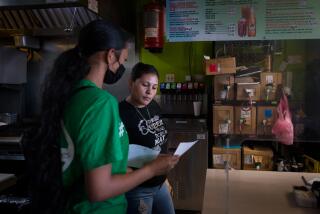Health Care Careers Beckon Teen-Agers : West Virginia: University officials hope they can keep predominantly black and economically disadvantaged children interested in professions.
- Share via
MORGANTOWN, W.Va. — Tanai Alston peppered the doctor with questions like any good first-year medical student, wanting to know as much as he could about the chest X-ray showing an advanced state of lung cancer.
“You know what that is?” Dr. Michael Elnicki asked.
“Cancer,” Alston answered and fired off another question almost as quickly as Elnicki said yes.
Sharp, but at just 13, Alston and the other 46 students attending the weeklong Health Sciences and Technology Academy at West Virginia University have another seven years of school before applying to medical school.
Officials at the university’s Robert C. Byrd Health Sciences Center are hoping they can keep these and other predominantly black and economically disadvantaged children interested in pursuing an education that would eventually lead to health care professions.
“The purpose is to spark their energy and their interest early toward careers that they may not otherwise think about,” said project director Ann Chester.
At the heart of the weeklong program is the hope that these students will one day earn a degree in nursing, pharmacy, dentistry or medicine and return home to areas in desperate need of health care providers.
“These are the students that live in the areas that need the health care, that need the professionals worse than other areas,” Chester said.
“What better way to get health care and technology into those areas than to pull the students from those areas, have them go through the career preparation processes and go back into the community and practice?” she said.
Alston comes from McDowell County, which ranks among the worst in unemployment in a state that does the same nationally. He said the academy only strengthened his dream to become an anesthesiologist.
“I’ve always wanted to be a doctor when I grow up and I didn’t really want to be around a lot of blood,” he said. “All (anesthesiologists) do is shoot people, put them to sleep and make a lot of money.”
Elnicki, who specializes in internal medicine, called the program a “neat idea” as he prepared to show another small group of students X-rays, images of a person’s brain and a device that lets them see their heart beat.
“They’ve actually had some very good questions,” he said. “This last group wanted to know how long it took to go through medical school? How much does it cost? Is there some way you can get your education paid for?”
In another half-hour class, Eddie Leonard, 13, intently tried to find the pulse of Barrington North, 14. They were learning how to take a blood pressure reading as part of a lesson on nursing.
“This is interesting,” Leonard said. “I’m learning a lot.”
Chester said the academy will become part of another program for recent high school graduates interested in health care professions and a two-day program for younger students who show an interest.
Community and school programs, like health sciences clubs, will fill in the gaps, she said.
“What we’d like to do is take it across the state, focusing on areas of highest need,” Chester said. “We want to make sure students that are brought into the program stay in the program until they hit college.”
“This gives you a chance to see opportunities in job careers which you would probably never get to see so up close, plus you get to see what it’s like to go to a university,” said LaRahn Davis, 15.
Salaries were a popular question among the children. Davis was particularly interested in how much Barbara Komives, director of the university’s dental hygiene program, thought her students could make.
“I’m not trying to be personal, but how is the pay?” he asked. “Good enough to have a (Mercedes) Benz in the garage?”
Komives assured him that a dental hygienist could draw a good salary and have a “Benz in the garage.”
More to Read
Sign up for Essential California
The most important California stories and recommendations in your inbox every morning.
You may occasionally receive promotional content from the Los Angeles Times.













